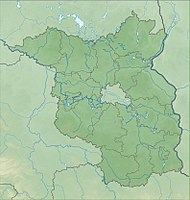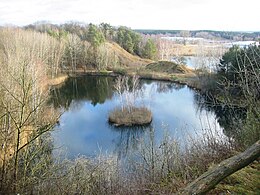Sperenberg Gypsum Quarries nature reserve
|
Sperenberg Gypsum Quarries nature reserve
|
||
|
Remaining hole 1 in the nature reserve |
||
| location | Brandenburg , Germany | |
| surface | 23 hectares | |
| WDPA ID | 82611 | |
| Geographical location | 52 ° 8 ' N , 13 ° 23' E | |
|
|
||
| Setup date | March 13, 1998 | |
The Sperenberger Gipsbrüche nature reserve is a 23.77 hectare nature reserve in the Teltow-Fläming district in Brandenburg .
History and location
Under the nature reserve there is around 250 million years old, Zechstein Age salt , which came to the surface through tectonic movements. By leaching so was gypsum , which was removed from the 12th century to the 1958th Large amounts of water were pumped out to prevent water from penetrating the gypsum break. A large amount of rock salt ended up in the nearby Krumme See : in 1907, for example, it was 140,000 tons. The increase in salinity and the collapse of depleted underground cavities meant that mining was finally stopped. After 1958 the area was no longer cultivated and placed under nature protection in 1998. It essentially comprises four former remaining holes of the former plasterwork construction, which are north of the Krumme See. But only three of them are part of the nature reserve. The remaining hole 2 was used, among other things, as a company landfill. Here, the first deep well in the world was carried out in 1867 to 1871, in which at 1271.60 meters drilled was. A panoramic path leads from the Evangelical village church in Sperenberg in a south-easterly direction past the four holes. Part of it runs on the 66 lakes regional park route , and then heads north over the Gipsberg back to the church. The Boden geo path leads through the nature reserve .
flora
In the rock-like outcrops with overgrown slopes and dry sole areas you can find the steppe timothy , the sand cinquefoil , the Carthusian clove, the reddish cinquefoil and the eared blue loosestrife . The abrupt edges with the ledges are the habitat of warmth-loving bushes such as the field rose and the low-scent rose . The sloe , buckthorn and common hawthorn can also be found . On the calcareous soils thrives dry grasslands , Middle Dost , Pigeon Skabiose , Alpine clover , milkweed and the narrow-bird vetch . The pre-forest consists mainly of quivering aspen , pine and sand birch . The middle mermaid and candelabrum algae grow on the remaining holes . In the western part around the remaining hole 1 there is a smooth oat meadow with the rough carnation ; in the eastern part the silver grass thrives .
fauna
In the Sperenberger gypsum quarries so far around 90 butterfly species were found, such as the butterflies , cutworm , Spanner , corn borer and the winder . The sand lizard and the moor frog are also native there. The kingfisher and the chaffinch were also detected.
Individual evidence
- ^ Sperenberg municipal council (ed.): 500 years of Sperenberg, 1495–1995 , 1st edition 1995
- ↑ Landkreis Teltow-Fläming, Office for Agriculture and Environment (Ed.): On a good reason. Booklet for the Boden-Geo-Path in the Teltow-Fläming district , 1st edition, 2008, pages 21 and 22.
- ↑ Ordinance on the “Sperenberger Gipsbrüche” nature reserve , February 5, 1998, website of the Brandenburg regulation system, accessed on December 30, 2013.
- ^ Ministry for Rural Development, Environment and Consumer Protection of the State of Brandenburg: Von Schwedenlinden, Erummeln and Rummeln - Natural Monuments in Brandenburg , 1st edition 2007, p. 26
Web links
- World Database on Protected Areas - conservation area Sperenberger gypsum quarries (English)
- Soil-Geo-Path in the Teltow-Fläming district , accessed on December 30, 2013.
- The geological peculiarity of Sperenberg , website of Heimatstube Sperenberg, accessed on December 30, 2013.




